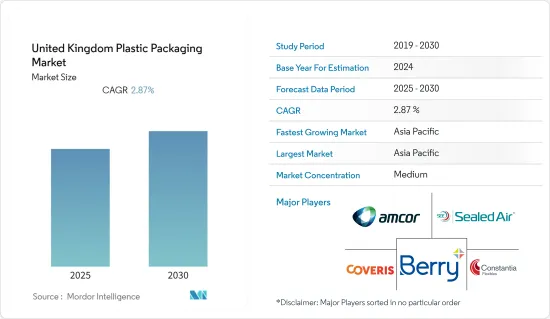PUBLISHER: Mordor Intelligence | PRODUCT CODE: 1640410

PUBLISHER: Mordor Intelligence | PRODUCT CODE: 1640410
United Kingdom Plastic Packaging - Market Share Analysis, Industry Trends & Statistics, Growth Forecasts (2025 - 2030)
The United Kingdom Plastic Packaging Market is expected to register a CAGR of 2.87% during the forecast period.

The UK packaging industry is expanding significantly due to the region's expanding industrial sector, which is driving up demand for packaging services there. The UK packaging manufacturing industry generated GBP 11 billion (USD 13.59 billion) in annual sales, according to the Packaging Federation of the United Kingdom. It employs more than 85,000 people, representing 3% of the manufacturing workforce in the United Kingdom. Furthermore, it plays a crucial role in the larger packaging supply chain and contributes significantly to the UK GDP.
The packaging sector in the United Kingdom is largely composed of plastic packaging. Furthermore, due to extensive manufacturing capabilities, it is expected that the UK market for plastic packaging would generate a sizeable amount of income. The UK Parliament estimates that five million tons of plastic are used there annually, with packaging accounting for approximately half of that.
Due to the growth of the flexible packaging industry, plastics are also in demand in the United Kingdom. The market need is being helped by both the expansion of international vendors in this area and the acquisition of local businesses.
Among various industries using plastic, the dairy industry is focusing on reducing plastic use. The UK's Food and Farming Minister, Lord Rooker, called for the country's dairy industry to become more sustainable, targeting a 50% reduction in the number of plastics used in milk packaging. That indicates even more growth for greener packaging in a country that has already shown innovative diversity.
Brexit is anticipated to increase plastic packaging costs in the United Kingdom due to rising trade regulations between the European Union and the United Kingdom, a shortage of skilled labor, a loss of competitiveness for local resin producers, and a decline in plastic recycling rates, all of which could potentially have an impact on the country's plastic packaging industry.
With the outbreak of COVID-19, the UK packaging market witnessed a decline in growth, owing to the widespread lockdown measures adopted by the government and supply chain disruptions. All the sectors, except healthcare and food and beverage, were shut down in the country. There has also been an impact of the Russia-Ukraine war on the overall packaging ecosystem.
UK Plastic Packaging Market Trends
Food Industry Driving Prominent Growth
Food packaging is one of the most significant users of plastics. The demand for plastic packaging in the food industry is increasing. They are increasingly replacing traditional materials, such as paperboard, metals, and glass, owing to their beneficial properties, such as lightweight and reduced cost.
The preference for processed and packaged foods has propelled the food packaging market in the region due to rapidly developing lifestyles and economic growth. The main reason for the increasing preference for processed food is the shifting population dynamics toward urban centers from rural areas.
However, the region is witnessing an increasing amount of plastic packaging waste (by 2% annually). The EU Commission is considering the general ban on plastic packaging, which is expected to constrain market growth. Virginijus Sinkevicius, the new EU Commissioner for Environment, stated that they are planning to ban plastic packaging or the usage of recycled plastic.
Over the forecast period, stand-up pouches are expected to become a standard form of food packaging due to their ability to retain the freshness of food products and extend the shelf life of products. In addition, the pouches also offer a great visible aesthetic, adding to the marketing benefits of products. This has led to the wide adoption of pouches as a stable alternative to other formats and is expected to take further momentum in terms of demand and customer acceptance during the forecast period. In the United Kingdom, sustainability and recyclability play a significant role in raising consumer preference toward brands.
Flexible Packaging is Expected to Observe Significant Growth
UK Plastic Packaging Industry Overview
Additional Benefits:
TABLE OF CONTENTS
1 INTRODUCTION
- 1.1 Study Assumptions and Market Definition
- 1.2 Scope of the Study
2 RESEARCH METHODOLOGY
3 EXECUTIVE SUMMARY
4 MARKET INSIGHTS
- 4.1 Market Overview
- 4.2 Value Chain Analysis
- 4.3 Porter's Five Forces Analysis
- 4.3.1 Threat of New Entrants
5 MARKET DYNAMICS
6 MARKET SEGMENTATION
7 COMPETITIVE LANDSCAPE
8 INVESTMENT ANALYSIS
9 FUTURE OF THE MARKET




